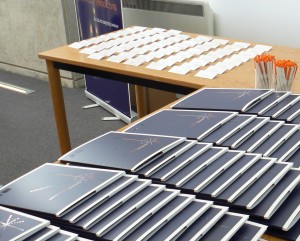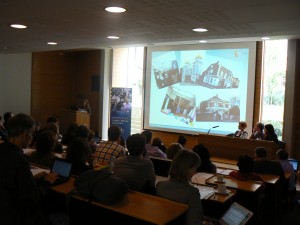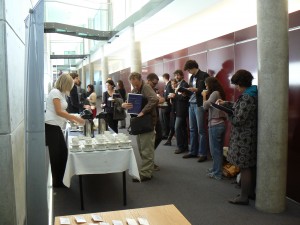The intensification of global flows in the current period has led scholars to describe cities like London as ‘super-diverse’: a ‘diversification of diversity’, with a population characterised by multiple ethnicities, countries of origin, immigration statuses, and age profiles (Vertovec 2007). Last week about 70 scholars, students and policy analysts from across Europe, North America, the UK, and Japan convened in Oxford to discuss the implications of super-diversity for ethnographic research, and for the ways in which we conceptualise urban space. 
While multi-sited ethnography is now well established, enabling ethnographers to study mobile people across multiple locations, there have been relatively few attempts to research multiple migrant communities sharing specific locations. We – the conference organisers (Mette Louise Berg, Ben Gidley, Vanessa Hughes, Nando Sigona) – wondered how we can develop the methodological tools required to achieve this.
Ethnography, both in the anthropological and sociological traditions, has tended to prefer long-term immersion in discrete, bounded ethnic communities – a model that is increasingly problematic in the context of super-diversity. In terms of urban space, we wanted to understand how emerging forms of multiculture are structured in and by urban space, and how urban space is structured in and by the multiplication of diversity.
The diversification of diversity means that the landscape of the city is experienced in ever more various ways. Some people have no choice but to move, while for others mobility is ever more constrained. Places are hyper-linked to distant places by new communication technologies that compress time and space in other ways, enabling unprecedented flows of information, images and money, and of affect, memory and longing.
We issued a call for papers addressing these issues and were overwhelmed by the response; clearly our concerns resonated with other scholars working on issues of migration, multiculturalism and belonging in fields as diverse as anthropology, architecture, geography, social policy, and sociology. 
The metropolitan paradox
In his welcome address, Ben Gidley noted what Les Back has called the metropolitan paradox, namely the co-existence of intense conviviality and intense conflict in the urban context. The challenge of making sense of this paradox reverberated through the conference.
In their paper, Sophie Watson and Anamik Saha (Open University), suggested that in Britain the movement towards a multi-ethnic, multicultural society happened willy-nilly, in a humdrum, lackadaisical way – as invoked by Stuart Hall’s notion of ‘multicultural drift’. In a similar vein, Susanne Wessendorf (Max-Planck-Institute for the Study of Religious and Ethnic Diversity) argued that in places like Hackney, East London, ethnic diversity is so common-place that nobody cares to comment on it. Such ordinary, mundane aspects of this multiculturalism are not captured by policy lenses which in turn have proclaimed the failure of multiculturalism. As Sarah Neal (Open University) argued, there is a political and media appetite for segregation stories, but empirical evidence points towards dispersal.
How best to capture the everyday, lived aspects of super-diversity was an abiding question throughout the conference. The terms ‘conviviality’, ‘cosmopolitanism’, ‘everyday multiculture’, and ‘commonplace diversity’ share semantic space, each term carrying its own history and disciplinary baggage.
Nick Mai (London Metropolitan University) noted the critique of cosmopolitanism for referring only to that which is verbalised, and argued for the importance of appreciating the embodied aspects of mobility and diversity in his paper on migrant sex workers in London. Alex Rhys-Taylor (Goldsmiths) focused exactly on the sensuous, embodied materiality of multiculture. In his paper, he attempted to capture the aroma-scape of multiculture, as evinced in a jerk chicken bagel, the most popular sandwich at ‘Mr Bagel’ in Ridley Road market, Hackney, East London. As Rhys-Taylor argued, the jerk chicken bagel emerges from the necessity to make a living, and is emphatically not an instance of happenstance. Rather, it is related to Europe’s colonial history and its history of anti-semitism, bringing bagel and jerk chicken into the same historical space.
Remembering and forgetting
The importance of history and the related themes of memory and forgetting ran through many of the papers. Lars Meier’s (Munich University) paper on Werderau, a corporate ‘village’ in the city of Nuremberg, vividly illustrated the interlinking of remembrance and forgetting.
Werderau was constructed in the early twentieth century as housing for workers at the nearby MAN factory. Meier’s research with retired, industrial workers, brought forth strong nostalgia for an imagined monocultural past, a golden era of a socially harmonious and homogeneous neighbourhood in the 1940s, ’50s and ’60s. As Meier himself noted, the neighbourhood had in fact always been socially more diverse than his elderly interviewees remembered, but strong social control had ruled out any public recognition of difference. In discussion, Hannah Jones (Goldsmiths) remarked that the Holocaust had also been forgotten in these narratives, raising important questions about how we as researchers use the narratives of people we talk to, and how we represent silence.
Forgotten histories and obliterated traces of diversity vs imagined homogeneous pasts was also important in Garbi Schmidt’s (Roskilde University) paper on the Copenhagen neighbourhood of Nørrebro. Schmidt argued for the importance of a historical approach to diversity, and the need to trace histories of immigration and diversity across time, leading us to a better appreciation of how the concept of the migrant changes over time, or conversely, remains stable.
Ethnocentrism in migration studies
In his keynote, Michael Keith (COMPAS) noted that citizens move between states, migrants move between countries, but people move between places, and most often we move to cities. He therefore argued for the importance of re-inscribing migration at the heart of studies of the urban, and of re-inscribing the urban at the heart of studies of migration. While papers at the conference overwhelmingly focused on European and North American cities with the exception of Caroline Osella and Abigail Wood’s (SOAS) paper on Jerusalem, Keith argued for the importance of learning from cities in the south.
This was echoed several times during the conference in calls for the need to understand diversity more broadly in time and space, and to appreciate the diversity of cities in Africa, Asia and the Middle East, which in many cases has existed for centuries and is not always related to migration. Camille Schmoll (University of Paris, Diderot) and Giovanni Semi (University of Turin) critiqued the over-representation of the north-Atlantic region in migration studies, and called for a recognition of Francophone ethnographic literature on circulations and informal trade in the Mediterranean.
In the concluding discussion Karen Fog Olwig (Copenhagen) reflected on the notion of diversity itself. She argued that it is a productive term, with a focus on processes of identification rather than on points of origin. In this context it is important to remember that diversity can take radically different shapes and forms, but there is still too much of a tendency to cast it in terms of national frameworks, race, and class.
More information on the conference: 